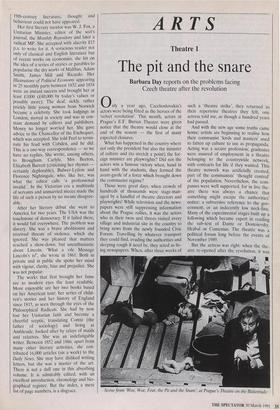This vigilant, resolute, sagacious bluestocking
Robert Blake
HARRIET MARTINEAU: SELECTED LETTERS edited by Valerie Sanders OUP, £30, pp.302 his is a selective collection of 100 or so letters by that celebrated 'miscellaneous writer' as she is described in the DNB, one of the arch bluestockings of the 19th centu- ry, radical, feminist (up to a point), self- confident, didactic and courageous. The letters need to be read, as the editor points out, in conjunction with Harriet Martineau's Autobiography, a fascinating book which ends in 1855 and was complet-
ed because of a morbid fear of imminent death. In fact she lived till 1876, when she died at the age of 74.
She was one of the ten children of a Unitarian family of Huguenot descent who worshipped at the famous Octagon Chapel in Norwich, one of the architectural master- pieces still surviving in that splendid city. Educated admirably at home, she realised only at the age of 11 that she was deaf. Her bombazine-manufacturing father was ruined by the 'recession' of the mid 1820s. Her sisters went out as governesses. Deafness precluded that career for her. She resolved to earn a living with her pen. `Nothing', she wrote in 1827, 'occupies my mind so entirely and beneficially as writing, with the exception of letter-writing.' Luckily she did not allow that exception to inhibit her. If it had, this revealing insight into
19th-century literature, thought and behaviour could not have appeared.
Her first literary mentor was W. J. Fox, a Unitarian Minister, editor of the sect's journal, the Monthly Repository and later a radical MP. She accepted with alacrity £15 p.a. to write for it. A voracious reader not only of classical and English literature but of recent works on economics, she hit on the idea of a series of stories or parables to popularise the dry works of Malthus, Adam Smith, James Mill and Ricardo. Her Illustrations of Political Economy appearing in 25 monthly parts between 1832 and 1834 were an instant success and brought her at least £1000 (£40,000 by today's values or possibly more). The deaf, sickly, rather prickly little young woman from Norwich became a celebrity. She took lodgings in London, moved in society and was in con- stant demand by editors and publishers. Money no longer worried her. She gave advice to the Chancellor of the Exchequer, which was accepted. She told Peel to termi- nate his feud with Cobden, and he did. This is a one-way correspondence — so we have no replies. She wrote, among others, to Brougham, Carlyle, Mrs Beeton, Elizabeth Barrett (criticising her rhymes certainly deplorable), Bulwer-Lytton and Florence Nightingale, who, like her, was what the editor calls 'a professional invalid '. In the Victorian era a multitude of servants and unmarried nieces made the life of such a person by no means disagree- able.
After her literary debut she went to America for two years. The USA was the touchstone of democracy. If it failed there, it would fail everywhere. The problem was slavery. She was a brave abolitionist and received threats of violence, which she ignored. She was pleased that matters reached a show-down, but unenthusiastic about Lincoln. 'What a vile Message Lincoln's is!', she wrote in 1861. Both in private and in public she spoke her mind with vigour, clarity, bias and prejudice. She was not popular.
The works that first brought her fame are to modern eyes the least readable. More enjoyable are her two books based on her American tour; her series of child- ren's stories and her history of England since 1815, as seen through the eyes of the Philosophical Radicals. She had by now lost her Unitarian faith and become a cheerful sceptic, translating Comte (the father of sociology) and living at Ambleside, looked after by relays of maids and relatives. She was an indefatigable writer. Between 1852 and 1866, apart from many other literary activities, she con- tributed 16,000 articles (six a week) to the Daily News. She may have disliked writing letters. but she was a master of the art. There is not a dull one in this absorbing volume. It is admirably edited, with an excellent introduction, chronology and bio- graphical register. But the index, a mere list of page numbers, is a disgrace.



















































 Previous page
Previous page